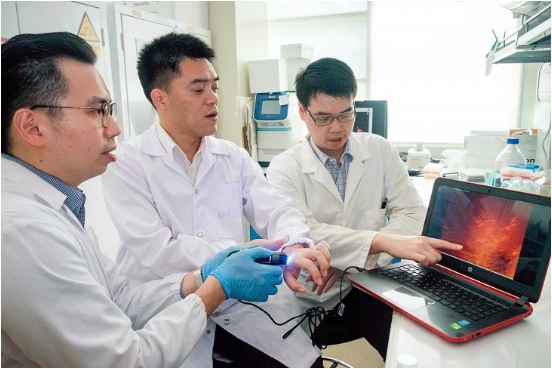Interactive platform for peer studying on biological and general microscopy. Dino-Lite microscope provide one of the most important platform in the field of studying biological sciences and general microscopy science. It allows students and lectures as the user to peer into the world of the cell, as well as discover the fascinating world of microscopic organisms and specimen with micron precision.
Detect Abnormal Scar Formation

It was very hard and painful to detect skin diseases. The only tool was to perform a biopsy, where a skin tissue sample is extracted and sent for laboratory testing. The procedure is very inconvenient for patients, and an open wound also risks infections and needs suture which must be removed later.
Recently, a new technique was developed by a team led by Assistant Professor Xu Chenjie from Nanyang Technological University’s School of Chemical and Biomedical Engineering, nanoscience expert Professor Chad A. Mirkin from Northwestern University and Dr Amy S. Paller, Chair of Dermatology at Northwestern University Feinberg School of Medicine.
The new method is much more painless and allows doctor to take preventive measures earlier to help reduce the chances of serious scarring. Using new nanoparticles, the joint research team has shown in animals and human skin samples the potential to quickly and accurately predict whether a wound is likely to lead to excessive scarring as occurs in keloids and skin contractures.
Published last month in the Nature Biomedical Engineering journal, the new detection method uses thousands of nanoparticles called NanoFlares, which have DNA strands attached to their surfaces like a ball of spikes.
These nanoparticles are applied to closed wounds using a cream. After the nanoparticles have penetrated the skin cells for 24 hours, a handheld fluorescence microscope is used to look for signals given out by the nanoparticles’ interaction with target biomarkers inside the skin cells.
Using the Dino-Lite AM4115T-GFBW, when fluorescence signals are detected, they indicate abnormal scarring activity and preventive action can be taken to hopefully avoid heavier scarring.
Assistant Professor Xu Chenjie said: “When our bioengineered nanoparticles are applied on the skin, they will penetrate up to 2mm below the skin surface and enter scar cells.”
In other recently published or accepted peer-reviewed journal articles, such as in a SLAS Technology commentary, Dr Yeo further elaborates on the potential applications of NanoFlares for other skin diseases such as skin cancer, since the DNA sequences on the nanoparticles are interchangeable.
The team has filed a patent application based on this technology through NTU’s innovation and commercialisation arm, NTUitive, and will conduct a clinical trial by mid-2019.
References:
New nanoparticles help to detect serious wound

